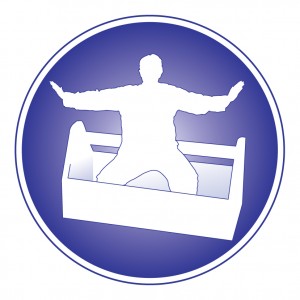Soon after I took over as the director of Brookline Tai Chi, we were hosting Bruce Frantzis for a Circling Hands seminar.
In the most basic version of Circling Hands qigong, you make a vertical circle out in front of your body, with your palms facing each other, focusing on smooth breathing, continuous pumping, and evening out the circle more and more with each pass (no corners or edges!).
In this seminar, Bruce was weaving meditation into the exercise and the goal was very simple: as you extend your arms out away from the body, you bring your mind into your body as much as you can. As the arms come close to the body, you send your mind out.
The beauty of circular movement, of course, is that you naturally begin to smooth out the transition from one phase to the other. But ultimately, it wasn't the exercise itself that made a lasting impression on me, it was a conversation Bruce and I had during one of the breaks.
I was asking Bruce for some advice about creating the right experience for our students. As we were talking, he led me to see that the meditation exercise with Circling Hands was the perfect metaphor for what we striving to create at BTC. In Circling Hands as meditation, you focus on creating an external shape that allows your awareness to go inside. At BTC, we were offering up a big, beautiful space to our students, with the hope that they would be inspired to explore their own big, internal space. The context for the practice sets an example for how the practice itself should be done.
I've been fascinated by this interplay between "Outer Form" (the shapes of the movements, the practice environment, etc.) and "Inner Form" (your mindset, how you turn your awareness inward, what you uncover as you practice), ever since.
Recently, an email I received from a student reminded me of the conversation years ago with Bruce. She wrote:
Here with a related question, since I just also ran into this at the tai chi-a-thon when I partnered with a woman who asked about a way to hold postures. Would there be a way to have a weekend workshop to introduce people to some of the elements of an internal form? I know you can't do much in a few hours toward getting someone actually to pulse all the different things that can be pulsed, or lengthen down yin and yang surfaces, or bend the bow, work on ligamental bounce, and the like, but at least in these two cases, I noticed that people don't really have a mental map telling them that this territory exists. I suspect that they've covered some of the ground in various classes but have the knowledge linked only with whatever particular form or movement they were studying and may not realize that the principles are transferable or know how to carry them over.
We went on to have a conversation that was ultimately about "how you do what you do when you do your movement practice" or simply, your Inner Form.
There are some really interesting layers to this distinction, many of which I hope to explore in upcoming posts. For example:
- At what learning stage is it appropriate to focus on Inner Form? (Is it on day one? Maybe not.)
- When is it better to use an Outer Form mindset?
- In the traditional sense, is Inner Form only neigong -- developing sensitivity to the natural pumps, springs, and connections that run your body -- or is it more about the mind and even an a mindset?
- Can you create a set of rules that leads you to the Inner Form?
Navigating Inner Form and Outer Form can be tricky, but I want to parse it in a few different ways with you. To make it easier to know what we're talking about, I'm going to use this new Inner Form icon to call out key articles, videos, and discussions about the Inner Form as we go:


Share this post
Twitter
Google+
Facebook
Reddit
LinkedIn
StumbleUpon
Pinterest
Email